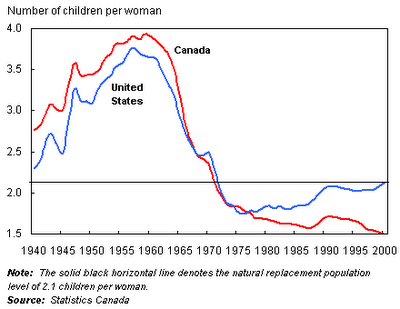

When a population gets older (the median age goes up - meaning half of the people are older and half younger) there are less people in age to have kids.
This means, in order for the population of a country (with higher median age) to remain stable these fewer younger people will have to have more and more kids... This is why the populations of these countries are almost certain to decline... And never recover... the same numbers.
I hope someone can add to this explanation.
“As “demographic winter” descends over Europe, plunging birthrates coincide with heavy immigration, primarily from Muslim lands. Following the logic of Mark Steyn’s America Alone, many conservatives have largely written off “old Europe” as a lost cause,” Dr. Allan Carlson, founder and International Secretary of the World Congress of Families, wrote for Human Events on March 22, 2007.
European Union? European Ostrich!
Ben Wattenberg
http://www.jewishworldreview.com -- CONSIDER HOW JOSEPH CHAMIE, Director of the United Nation's Population Division, distills the new and very controversial U.N. publication "Replacement Migration: Is It a Solution to Declining and Aging Populations?"
He looks at the current foundation of the demographic future and says, "This is the only time in history where people are living longer and populations are shrinking" -- but, he quickly notes, it doesn't apply to America. (For that, we Americans are blessed.)
In short, we are looking ahead to a world where, in most of its modern parts, people will be many fewer and much older. As Casey Stengel used to say, that is a true fact. Which is why it is not a popular one in some quarters, particularly when the news is delivered by the United Nations. After all, most of the time U.N. agencies are stressing (overstated) forecasts of population growth in faraway underdeveloped countries, rather than the wrenching implications of shrinking populations in proud Europe and insular Japan.
Speaking officially for all the nations of Europe, Joao Fins-do-Lago of Portugal responded to Chamie's truth-telling effrontery thusly: "The report presents a one-dimensional approach to the highly complex issue of population aging.... We would have appreciated that the document... been provided... before being presented to the press and the public.... This is an essentially distinct phenomena.... Future work must be done at a national and regional level."
And so, official Europe continues in official denial. Let's call the European Union what it is: the European Ostrich. The operative and misleading word in Fins-do-Lago's statement is "distinct." The root causes of the future sharp rise of median age are not distinct at all, and everyone knows it. Longevity is expanding in most every developed country but Russia, which is in crisis. And birth rates and fertility rates have fallen sharply in every area of the world in recent decades. In Europe the Total Fertility Rate (TFR) is 1.4 children per woman, about a third below the 2.1 rate required to merely "replace" a population over time. In America the TFR is 2.0.
Chamie and his colleagues have capsulized the problem with the path-breaking phrase, "replacement migration." Just as a "replacement fertility" rate tells us how many babies are needed to keep a population stationary, so "replacement migration" tells us how many migrants are needed to:
1. keep population from falling;
2. maintain the size of a working population;
and
3. keep the ratios of workers to retirees
from falling.
The numbers for Europe are impossible. Europe is projected to take in 23 million immigrants from 1995 to 2050. But Europe would need 100 million immigrants to keep its population from falling, 161 million immigrants to keep the working-age cohort from falling and 1.4 billion immigrants to keep the ratio of workers to retirees from falling.
Not going to happen. Europeans are already burning mad at even the current immigration level. European elites excoriate anti-immigration politicians like Austria's Jorg Haider and France's Jacques LePen, comparing them to skinhead Nazis. But, nonetheless, mainstream European policies are turning increasingly against any form of immigration.
But what's the problem with an aging society? People living longer -- that's the good news, isn't it? Yes. But the bad news, thinks Chamie, goes beyond the projected shortfall of worker-bees to sustain current levels of government pension plans. After all, these are rich societies. Europeans will survive, even with lower pensions than now, and perhaps with even more assets per capita than now, due to the increasing payoff from technology.
But, Chamie wonders, what happens when the cash on hand can't buy the desired and needed services for the elderly?
Think about it: Who will wash the dishes in the lush restaurants? Who will wash the infirm elderly? Who will clean the bedpans, mow the lawns and sack the groceries? Surely not the ever-diminishing numbers of working-age adults emanating from the darlings of the model 1.4-child European family.
In short, Europeans don't want immigrants, but they want what only immigrants can provide. Fortunately, this time the European press is not in on the denial deal. The new U.N. report has been played widely. And why not? Many European nations are on their way to a going-out-of-business sale. In Spain, the proportion of elderly is expected to grow by 117 percent by 2050, while the nation loses 24 percent of its population, which will continually compound upon itself as, and if, the Birth Dearth continues.
America has its own problems with aging and pension support, but they are slam-dunks by European standards.
Chamie calls the 20th century "the demographic century." Between the Population Explosion and the Birth Dearth, he is right. But we ain't seen nothing yet. And ostriches see nothing until it's too late.
Ben Wattenberg is a senior fellow at the American Enterprise Institute and is the moderator of PBS's "Think Tank."

http://en.wikipedia.org/wiki/Demographics_of_Europe
http://en.wikipedia.org/wiki/Demographics_of_Russia
http://fr.wikipedia.org/wiki/Crash_d%C3%A9mographique
http://www.census.gov/ipc/www/idbpyr.html